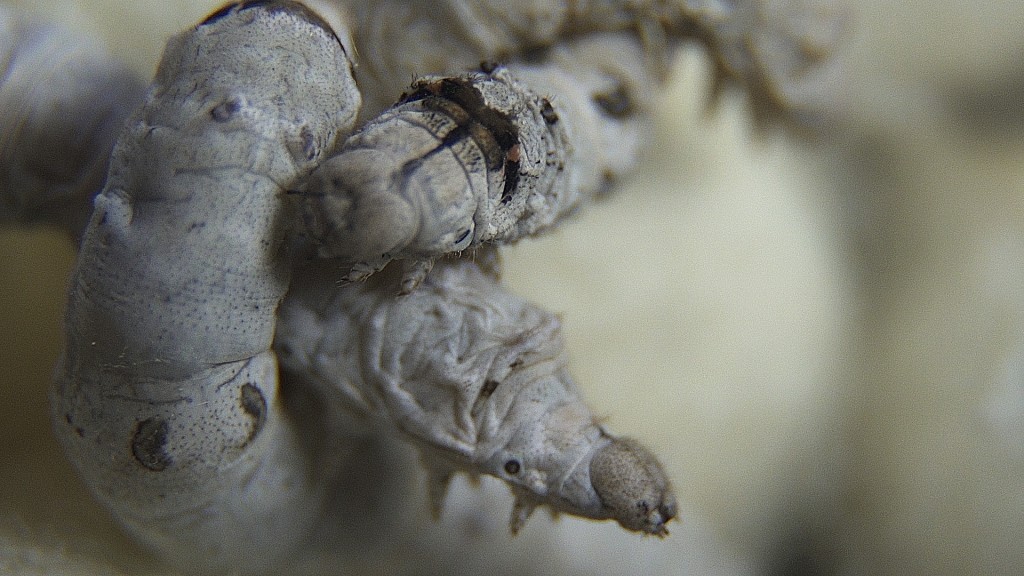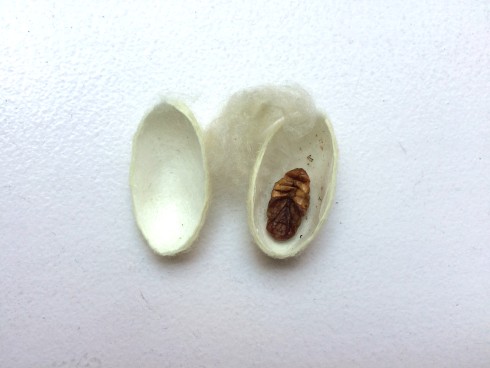Most of us are familiar with silk as a fine fabric that is made into neckties and dresses. As a textile, silk is highly valued because it is shiny and smooth, strong yet lightweight, and it can be easily dyed or treated to take on the color or chemical properties of other substances. These well-known properties led scientists to develop new products from silk, including important medical materials such as replacement cartilage, surgical sutures, and small spheres that can be used to deliver drugs to certain parts of the body (not all of these are available yet on the market). What many people do not realize is that the small silk fibers that give silk its desirable characteristics come from the mouths of caterpillars called silkworms.

The silk used by humans comes from the domesticated silkworm, Bombyx mori. The silkworm is the caterpillar of a moth in Lepidoptera, the order of insects that includes moths and butterflies. Lepidoptera are holometabolous insects, which means that they undergo a complete metamorphosis during their lifetime. Just like butterflies, silkworm moths begin their life as an egg that then hatches into a growing, feeding caterpillar. When a silkworm has eaten enough, it constructs a cocoon made out of silk fibers, and inside that cocoon it turns into a pupa. After many days, a fully formed adult silkworm moth emerges through a spit-soaked opening in the bottom of a cocoon.
Dissecting a silkworm cocoon before the adult has emerged provides many clues about the transformation of a silkworm into an adult moth—a change that is normally impossible to view through the walls of a cocoon once it has been constructed. In this activity, you’ll learn about the insect origins of silk by dissecting a cocoon and “degumming” it to reveal the protein, called fibroin, that scientists use for constructing new materials.
Materials
Non-living, unemerged, silk cocoons – one or two per experimenter
Sharp scissors
Straight pins
4-6 inch square of cardboard or corkboard for pinning
Pencil
Paper for labeling
Beaker and hotplate, or saucepan and stove
Stirring rod or spoon
Plate or tray
Paper towels
Water
Powdered dishwasher detergent
Tweezers, fork, or tongs
Optional: camera
Optional: scale for measuring mass
Optional: silk cocoon dissection sheet
Materials Notes:
If you need help finding silkworms, try one of these online suppliers: Mulberry Farms, The Silkworm Shop, Oregon Silk Worms. You can download the silk cocoon dissection sheet here.
Cocoon Exterior – What is on the outside of a cocoon?
- Take a moment to make some observations about the color, shape, weight, size, and texture of the outside of the cocoon. Gently shake the cocoon and listen for anything inside. If you have a scale, measure the mass of the cocoon. Record your observations in a notebook or on the silk cocoon dissection sheet.
- Use your fingers to gently tug at the loose silk around the outside of the cocoon. You may find you are able to remove the exterior silk in one single sheet. Rub this silk between your fingers, describing the texture in your notes, then pin it to your pinboard and label it so that you can compare it to silk collected in later steps.
- Use your fingers to gently tug at the loose silk around the outside of the cocoon. You may find you are able to remove the exterior silk in one single sheet. Rub this silk between your fingers, describing the texture in your notes, then pin it to your pinboard and label it so that you can compare it to silk collected in later steps.
- Now, use a pin to snag some of the second layer of silk from the outside of the cocoon. Pull enough that you can feel it between your fingers and observe its texture, and record your observations. Pin this silk next to the silk you pulled off in the previous step, and label it.
A silkworm constructs its cocoon from the outside in, starting with a quick scaffold that it can easily rest upon while weaving and that will ultimately secure the cocoon to surrounding plants. The silk used to make the cocoon starts out thick but gets thinner and thinner as the silkworm works its way into the center of the cocoon.
Things to think about:
- Why do you think that it might be advantageous for a silkworm to use such thick, stiff silk during the initial stage of cocoon construction?
- How does the outer-most layer of silk differ in color, texture, and flexibility from the silk layer just beneath it?
Cocoon Interior – What’s inside of a cocoon?
- Using sharp scissors, nick the center of the cocoon, creating a hole just big enough to get the tip of your scissors into.
- Carefully, cut around the outside of the cocoon along the long axis. Stop periodically to peek into the cocoon and make sure that you are not cutting into anything that might be hidden inside. Cut until you have two halves.
- Once you’ve opened your cocoon, take a moment to sketch what you’ve discovered inside. If you have a scale, measure the mass of the empty cocoon and compare it to its original mass.
- Using pins, carefully pin the objects that you’ve found to your pin board, and try to identify them based on the information below. Pin one half of the cocoon to your pin board.
After constructing its cocoon, the silkworm caterpillar is fully encased inside. There, it will gradually stop moving and shed its skin-like caterpillar exoskeleton to emerge as a pupa, the intermediate phase between the caterpillar and the adult moth. The exoskeleton, called exuvia, is left in the bottom of the cocoon. A silkworm pupa already looks more like an adult than a caterpillar, with a shortened, segmented body, a clearly defined head, and the beginnings of what will be the adult legs. It takes the pupa approximately two weeks to develop into an adult moth.
Things to think about:
- Look closely at the pupa inside your cocoon. Can you find any structures on it that resemble the body parts of an adult moth? If you can, label them in your sketch.
- Were you able to find the discarded caterpillar exuvia? Make sure to label that in your sketch as well as on your pinboard if you pinned it.
- The pupa inside of your cocoon has likely been dead for some time. How do you think its body has changed since it was alive?
Cocoon Interior – How is interior silk different from exterior silk?
- Take your finger and touch the inside of the unpinned half of your cocoon. Record your observations in your notebook or on your dissection sheet.
- Use a needle to scrape gently at the inside wall of the cocoon half until you are able to pull a layer of silk away. Feel the silk between your fingers and, in your notes, compare its color, texture, and flexibility to the silk from the exterior of the cocoon.
The silk used to construct a cocoon is actually a single, continuous thread that can be over 900m long. The silkworm weaves its cocoon from the outside in, laying down silk in figure-eight patterns. As it does this, the silk fiber gets thinner and thinner.
Things to think about:
- How is the silk from the exterior of the cocoon different from the interior silk?
- How does a change in the thickness of the silk fiber affect its texture? Are bigger fibers from the exterior softer or rougher than the fibers that make up the interior of the cocoon?
- Based on your observations, from where on a cocoon would you pull silk if you wanted to weave it into a soft fabric?
Degumming your silk cocoon: How is silk processed for human use?
- In a large beaker on a hot plate or in a small saucepan on a stove, bring to a boil 2 cups of water with 2 tablespoons of a powdered dishwasher detergent. Line a plate or tray with two layers of paper towels.
- Add between 1 and 12 cocoon halves (pupae removed), and reduce to a simmer for 15 minutes, noting the color of the liquid as the silk is simmered. Periodically agitate with a spatula or stirring rod.
- Carefully remove the silk using tongs or a fork, rinse under cold running water, then rest it on your paper-lined tray. Once it has cooled, squeeze it in paper towels and let it dry.
The silk begins in the salivary glands of a silkworm as a clear, gooey liquid made of a strong protein called fibroin and a sticky protein called sericin. When it comes out of the silkworm’s salivary glands and is exposed to air, the mixture starts to solidify, changing from viscous liquid to a strong, stretchy fiber. The sericin, which coats the outside of the silk fiber, is important for cocoon construction because it helps the layers of silk adhere to one another to create a solid cocoon wall.
For human use as a textile and biomedical material, however, silk is most useful if the sericin coating that surrounds the fibroin fiber is removed before further processing. To do this, silk cocoons are usually boiled in a mild basic detergent. The process, called “degumming,” is what you just did with your detergent. Degumming dissolves the yellowish sericin in water and leaves behind white, wet, fibroin strands.
Things to think about:
- How is your degummed fibroin different from the silk fibers you collected from your cocoon earlier?
- How did the degumming process change the silk? Note the color, stiffness, strength, and texture of the fibroin silk in your notes.
Scientists are researching the various ways silk fibroin can be used to make new materials and devices with different properties and applications. In order to build new materials out of silk, they must first dissolve the degummed silk fibers to create an aqueous fibroin solution. From that point, they can process the silk fibroin solution into many different and adaptable materials. Watch the Science Friday Video “The Medical Wonders of Worm Spit” and read “The Silk Road’s Turn Toward Biotechnology” to learn more about a group of scientists engineering new materials from silk.
Educator's Toolbox
Meet the Writer
About Ariel Zych
@arieloquentAriel Zych is Science Friday’s director of audience. She is a former teacher and scientist who spends her free time making food, watching arthropods, and being outside.
